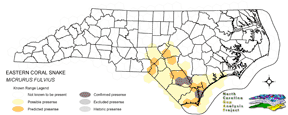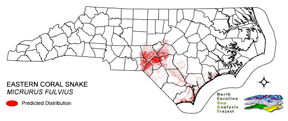
| Taxa: |
| Order: |
| Family: |
| Reptilia |
| Squamata |
| Elapidae |
| NatureServe Global Rank: |
| NatureServe State (NC) Rank: |
| G5 |
| S1 |
| Federal Status: |
| NC State Status: |
| --- |
| SR |


| Land Unit |
| US Fish & Wildlife Service |
| US Forest Service |
| US National Park Service |
| US Department of Defense |
| NC State Parks |
| NC University System |
| NC Wildlife Res. Com. |
| NC Forest Service |
| NC Div. of Coastal Mgmt. |
| Local Governments |
| Non-Governmental Org. |
| Other Public Lands |
| Private Lands |
| GAP Status 1-2 |
| All Protected Lands |
| Statewide |
| Hectares |
| 161.19 |
| 1,258.65 |
| 54,647.73 |
| 16.65 |
| 1,372.14 |
| 0.00 |
| 18,927.90 |
| 3,060.36 |
| 124.11 |
| 225.18 |
| 909.45 |
| 51.30 |
| 314,160.93 |
| 3,379.59 |
| 80,169.39 |
| 394,915.59 |
| Acres |
| 398.31 |
| 3,110.19 |
| 135,037.46 |
| 41.14 |
| 3,390.63 |
| 0.00 |
| 46,771.85 |
| 7,562.31 |
| 306.68 |
| 556.43 |
| 2,247.30 |
| 126.77 |
| 776,308.41 |
| 8,351.15 |
| 198,102.84 |
| 975,857.49 |
| % of Dist. on |
| Prot. Lands |
| 0.2 % |
| 1.6 % |
| 68.2 % |
| < 0.1 % |
| 1.7 % |
| 0.0 % |
| 22.9 % |
| 3.8 % |
| 0.2 % |
| 1.1 % |
| 1.1 % |
| < 0.1 % |
| 0.0 % |
| 4.2 % |
| ----- |
| ----- |
| % of Dist. on |
| All Lands |
| < 0.1 % |
| 0.3 % |
| 13.8 % |
| < 0.1 % |
| 0.3 % |
| 0.0 % |
| 4.8 % |
| 0.8 % |
| < 0.1 % |
| < 0.1 % |
| 0.2 % |
| < 0.1 % |
| 79.6 % |
| 0.9 % |
| ----- |
| ----- |
|
NATURE SERVE GLOBAL HABITAT COMMENTS: Texas: rocky creek banks and canyons of oak-juniper brakes, thorn brush chaparral of coastal plain, Cross Timbers woodland/thickets, pine-hardwood forest. Florida/Alabama: hardwood forest, pine flatwoods, xerophytic scrub; sometimes marshy areas and residential areas. Northern Mexico: mesquite- grassland, thorn forest, and desert, at elevations of generally less than 500 m; southern Tamaulipas: reaches 900 m in oak savanna; south end of range: apparently restricted to elevations above 800 m in pine-oak forest and mesquite-grassland (Campbell and Lamar 1989). Often underground, under leaf litter, logs or stumps, or similarly secluded. Eggs probably are laid in loose soil or decaying organic matter (Mount 1975), or underground or under leaf litter or surface objects (Ernst 1992). NATURE SERVE STATE HABITAT COMMENTS: Sandhills dominated by pines, scrub oaks, wiregrass, sandy flatwoods, and maritime forests. |
| Code | Name | Description | NC Natural Heritage Program Equivalent |
| 121 | Maritime Pinelands | Loblolly forests and woodlands of the outer coastal plain. | Estuarine Fringe Loblolly Pine Forest |
| 17 | Maritime Forests and Hammocks | Maritime forests and woodlands dominated by live or sand laurel oak. Estuarine Fringe forests dominated by loblolly pine. | Coastal Fringe Evergreen Forest, Maritime Deciduous Forest, Maritime Deciduous Forest |
| 97 | Mesic Longleaf Pine | Longleaf pine woodlands without a major scrub oak component. Slash or loblolly pines may be present as well. | Mesic Pine Flatwoods |
| 42 | Xeric Longleaf Pine | Sandhills including a range of longleaf pine density from predominantly wiregrass, scrub oak dominated to true longleaf pine woodland. This does not include mesic or saturated flatwood types. | Xeric Sandhill Scrub, Pine/Scrub Oak Sandhill, Coastal Fringe Sandhill |
| 46 | Xeric Oak - Pine Forests | Mixed forest dominated by yellow pines with white or northern red oaks co-dominating. | Pine Oak Heath |
| 382 | Dry Mesic Oak Pine Forests | Mixed forests of the coastal plain and piedmont. Includes loblolly pine with white, southern red and/or post oak and loblolly with water oak. On basic sites of the piedmont, eastern red cedar may co-occur with post, black, and blackjack oaks. | Dry Mesic Oak Hickory Forest, Xeric Hard Pan Forest, Chestnut Oak Forest, Dry Mesic Oak Hickory Forest, Dry Oak Hickory Forest |
|
Jackson, D. R., and R. Franz. 1981. Ecology of the easterncoral snake (Micrurus fulvius) in northern peninsular Florida. Herpetologica 37:213-228.
Dowling, H. G. 1993. Viewpoint:a reply to Collins (1991, 1992). Herpetol. Rev. 24:11-13. Gibbons, J. W., and R. D. Semlitsch. 1991. Guide to the reptiles and amphibians of the Savannah River Site. Univ. of Georgia Press, Athens. xii + 131 pp. Ernst, C. H. 1992. Venomous reptiles of North America. Smithsonian Inst. Press, Washington, D.C. ix + 236 pp. Slowinski, J. B. 1995. A phylogenetic analysis of the New World coral snakes (Elapidae:LEPTOMICRURUS, MICRUROIDES, and MICRURUS) based on allozymic and morphological characters. Journal of Herpetology 29:325-338. Roze, J. A., and G. M. Tilger. 1983. Micrurus fulvius. Cat. Am. Amph. Rep. 316.1-316.4. Mount, R. H. 1975. The Reptiles and Amphibians of Alabama. Auburn University Agricultural Experiment Station, Auburn, Alabama. vii + 347 pp. Behler, J. L., and F. W. King. 1979. The Audubon Society field guide to North American reptiles and amphibians. Alfred A. Knopf, New York. 719 pp. Martof, B. S., W. M. Palmer, J. R. Bailey, and J. R. Harrison, III. 1980. Amphibians and reptiles of the Carolinas and Virginia. University of North Carolina Press, Chapel Hill, North Carolina. 264 pp. Ashton, R. E., Jr., and P. S. Ashton. 1981. Handbook of Reptiles and Amphibians of Florida. Part One:The Snakes. Windward Pub. Co., Miami, Florida. 176 pp. Tennant, A. 1984. The Snakes of Texas. Texas Monthly Press, Austin, Texas. 561 pp. Collins, J. T. 1991. Viewpoint:a new taxonomic arrangement for some North American amphibians and reptiles. SSAR Herpetol. Review 22:42-43. Campbell, J. A., and W. W. Lamar. 1989. The venomous reptiles of Latin America. Comstock Publ. Associates, Division of Cornell Univ. Press, Ithaca, New York. xii + 425 pp. Dundee, H. A., and D. A. Rossman. 1989. The amphibians and reptiles of Louisiana. Louisiana State Univ. Press, Baton Rouge. Ernst, C. H., and R. W. Barbour. 1989. Snakes of eastern North America. George Mason Univ. Press, Fairfax, Virginia. 282 pp. |
For more information please contact them at:
NC-GAP Analysis Project
Dept. of Zoology, NCSU
Campus Box 7617
Raleigh, NC 27695-7617
(919) 513-2853
www.basic.ncsu.edu/ncgap